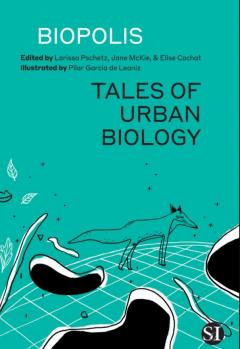Biopolis: Writers and scientists re-imagine the cities of the future
Alessia Lepore reflects on her experience of an artistic collaboration with a writer in exploring future cities.

January 11, 2021
Recently, ten teams of SynthSys scientists and professional writers worked together on a novel project to create stories about the impact of biotechnology on urban life. The outcome of this collaboration is an extremely interesting and varied collection Biopolis, Tales of Urban Biology.
Thanks to the unique and creative pen of the writers, each story explores the scientist’s research topic. Set in a future Edinburgh, the stories envisage a city where biotechnology is interconnected with its buildings and their inhabitants. Future landscapes designed for a better way of living. I am Alessia Lepore, one of the scientists, and reflect here on the experience of being part of one of these unusual duos.
"It was a really exciting experience for me and proved to be an excellent way to learn to engage with a wider audience than I usually communicate with. I was both intrigued and delighted to see my research through the eyes of a writer, hoping to learn (and perhaps borrow) some tricks from the their toolbox. Indeed, although scientists need more fact than fiction in our 'stories' (aka scientific papers and books), I do believe it is crucial we can still define and build a well-structured narrative in our manuscripts. Moreover, for the widest dissemination of our work, we need to keep our audience engaged – whether those are our peers or the general public.
The science-writer pairing process was random, but just by chance I was teamed up with a writer I knew, Andrew Wilson. I read one of Andrew’s stories and at the 'match-making' dinner (at the time eating out was still normal) we immediately started to share ideas for the story. Andrew and I then spent a half-day in the lab, when I showed him around and we set up an experiment together. I explained my research to Andrew, and he shared with me his early ideas for a story – one piece of science and one of fiction. The story was starting to take shape!
Over the following weeks, Andrew kept me posted on how his story was developing and I provided him plausible scientific explanations to his ideas. It was a pleasant surprise see how science and fiction worked so well together. When it was ready, I wrote a note on the science behind the story. Writing this commentary was a great way to practice how to communicate science to a non-specialized audience. The commentary gives the reader a better idea of how the fiction was derived from fact, giving an insight into the science in the story.
Collaborating with Andrew has been really stimulating: he gave me a unique perspective on my research and showed me how to introduce the elements of a story at the right place and right time. Advising Andrew about the science while he was creating the story reminded me of the importance of looking at the 'big picture' and helped me to reflect on the impact of my work beyond academia.
After this experience, Andrew and I agreed that scientists and writers have more in common than we had originally thought. Scientists and writers both tell stories albeit of a different nature and we both must take the time to perfect the narrative to deliver a truly compelling piece of work."
The project was coordinated by Larissa Pschetz, Jane McKie, and Elise Cachat, and is the result of a collaboration funded by the University of Sydney, Australia and the Edinburgh Futures Institute.
The book is published by Shoreline of Infinity.


